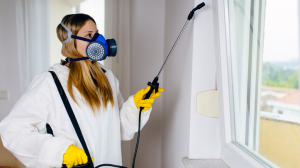Cabinet Refinishing Modesto is an affordable option to update your kitchen’s style. It can be done in a shorter time frame and may require less construction work than a complete replacement would.

Refinishing is a greener choice than replacing your cabinets, as it reduces the amount of waste in landfills and minimizes the need to produce new materials. It also reduces dust and mess generated during a remodel project.
Cabinet refinishing is an excellent way to update your home’s appearance without breaking the bank. It is also an environmentally-friendly option, as it preserves the original structure of your cabinets and keeps waste to a minimum. However, proper preparation is critical to ensure the new finish adheres correctly and minimizes imperfections.
This step involves cleaning the cabinet surfaces with a degreaser to remove dirt and grime, and then sanding the surface to smooth it out. This process is more thorough than simply scrubbing the surface with water, and it helps to ensure that the paint will hold on well and last longer. It is important to use a good quality sandpaper, such as 150 or 180 grit, to achieve the best results.
Primer is then applied to the surface, which acts as a sealant and adds durability. It is typically tinted to match the color of the final coat, allowing it to blend in with the existing cabinet finish and provide a more uniform look. Once the primer dries, it is ready to be painted.
When painting cabinets, it is important to apply thin coats and wait for each one to dry completely before applying the next. This allows for a more even and durable finish, and it prevents the build-up of moisture that can cause the wood to warp or crack over time.
When refinishing your cabinets, it is important to protect adjacent surfaces and furniture from paint splatter by covering them with tape and plastic. It is also a good idea to remove any hardware or handles from the cabinet doors and place them in a safe location. After the cabinets are painted, it is important to allow them to cure fully before using them again, which can take a few days or more depending on the type of paint used. Regular maintenance can keep them looking great, including wiping them down with a soft cloth and mild soap, avoiding harsh chemicals that could damage or discolor the finish, and removing any spills or stains as soon as they happen.
Staining
Cabinet refinishing gives you an attractive new wood look without the cost and mess of replacing your cabinets. During this process, the existing doors are sanded down and stained to enhance or alter their color. If your cabinet doors have been painted, a liquid paint stripper or scraper is used to remove the old layer of paint. If the bare wood shows through, you may choose to stain the cabinets a darker shade than the original, or leave it a lighter shade if that’s your preference.
It’s important to sand the wood prior to staining to ensure that the new stain adheres. A power sander is often employed for larger flat surfaces, while manual sanding with fine-grit sandpaper will be necessary to reach narrow spaces and other nooks and crannies. When staining, be careful not to apply too many coats, as the wood can absorb only so much. Also, the duration that the stain is left on before being wiped off will impact the final color. Wiping it off immediately or within a few minutes will result in a lighter finish, while leaving the stain on for five to 10 minutes will give you a deeper color.
Staining is an ideal way to refresh your kitchen or bathroom, providing a more natural wood look than paint. It can be easily applied to cabinetry with a brush or cloth, and stains are available in a wide variety of colors to suit your style and décor. Unlike painting, refinishing doesn’t require masking, and you can reinstall your doors and drawer fronts right away.
The Furniture Medic technicians can transform your cabinets through a variety of color changes. Our experts can work with your existing doors and drawer fronts to create a fresh look, while also addressing any exterior touch-ups and repairs.
The refacing process is more extensive than refinishing, as it involves installing new cabinet doors and drawer fronts and adding new veneer or material to the existing cabinet boxes. It’s also pricier, though less costly than purchasing and installing completely new cabinetry. Choosing to reface your cabinets can be an excellent option for homeowners who want a dramatic change or make their home more appealing on the market, but isn’t willing to spend the extra money on a full cabinet replacement.
Sealing
Cabinet refinishing is a more environmentally friendly and affordable option than replacing cabinets. The process involves less waste and fewer airborne particles than tear-out and replacement, so it minimizes dust and mess throughout your home. As a result, you can get back to living in your kitchen much faster.
Before reattaching doors and drawers, re-check the alignment of each to ensure smooth operation and an appealing finished look. If necessary, adjust hinges and handles to achieve a flawless fit and even appearance.
When you’re done, apply 2-3 coats of clear polyurethane to protect your new finish from moisture and stains. Allow each coat to dry thoroughly according to the product’s instructions, sanding lightly between each application. Water-based polyurethane typically dries in less time than oil-based products.
Once your cabinet paint is completely dry, you can reinstall your door and drawer hardware. Using a clean rag, wipe down all surfaces to remove any excess clear polyurethane and ensure the surfaces are completely clean and ready for reinstall.
It’s a good idea to label each cabinet door with its corresponding number or letter, so you can easily find the right door when it comes time to reinstall them. This will also help prevent accidental mismatches, a common mistake in DIY projects.
Refinishing your cabinets can breathe new life into your kitchen and increase the overall value of your home. Whether you’re looking for an update to your current style or want to sell your home, this project can provide a dramatic transformation at a fraction of the cost of replacing them. With proper preparation, staining and sealing, your cabinets will be protected from everyday wear and tear and stand the test of time.
Cleaning
Cabinet refinishing is more environmentally friendly than replacing existing cabinets and minimizes dust and mess throughout the home. However, it is important to clean and dust your cabinets on a regular basis. This will keep them looking their best and extend their life.
To keep your cabinets in pristine condition, use a soft cloth or lint-free microfiber cloth dampened with a solution of mild dishwashing liquid and warm water. For oil or grease spills, a degreaser that is safe for cabinet finishes may be used. Be sure to test the product on a small, inconspicuous area to ensure it won’t discolor or damage your finish.
Empty your cabinets and wipe down all surfaces including the backs of shelves, trim and interior doors. Make sure you remove any old food or spices that are past their expiration dates and empty your drawers of any loose items. Then, vacuum the entire area with a crevice attachment to get into the corners and tight spaces. If you have any tough grease or oil stains, apply the multi-purpose cleaner using a sponge, brush or cloth that is safe for your cabinet finishes. If necessary, let the cleaner sit on the greasy spot for a few minutes before wiping it away with a dry cloth.
Avoid using harsh chemical products on your cabinets, especially those containing bleach, ammonia or citrus products. These will dull and damage the finish over time. For stubborn stains, try scrubbing them with a soft, non-abrasive scrub brush or toothbrush, then wipe the surface again to remove any residue.
Lastly, to keep your cabinet hardware shining bright, soak a clean cloth in vinegar and water. This will help to release any accumulated gunk and dirt on your door knobs or handles. Be sure to dry the surface immediately afterward to prevent water spots.







